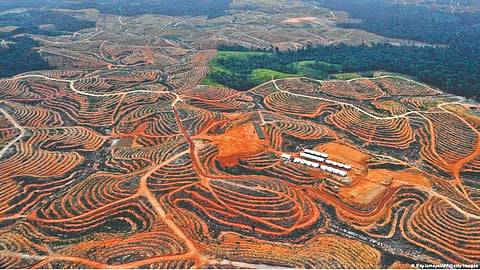

NEW DELHI: When Indonesia’s government decided to build a new capital, environmental defenders sounded the alarm. Sinking Jakarta will be the first metropolis to lose its capital status due to the climate crisis.
But the decision to house the seat of government on the lush island of Borneo could worsen environmental damage in the archipelago and displace Indigenous communities from their ancestral lands, critics say.
While plans for a new capital city are recent, the fight for land rights is an old story for native Borneans.
In 2020, three Indigenous farmers were jailed after harvesting from land they said a palm oil firm stole from them. One of the farmers, Hermanus Bin Bison, died in police custody shortly after he was imprisoned.
Bison is just one of many environmental defenders globally who has paid the ultimate price for protecting the lands they inhabit from extractive industries or for working to protect the environment.
Businesses, criminal groups and governments have long violently displaced communities from their ancestral lands — and Indigenous people are seemingly more likely to be killed than other defenders. At least 613 Indigenous activists have been murdered over the last decade, according to data published by environmental and human rights watchdog Global Witness.
Between 2012 and 2021, rights groups and organizations documented the deaths of more than 1,700 environmental and land defenders in about 60 countries. More than 35% of those killed identified as Indigenous. But the true death toll is likely higher. Some 5% of cases documented by Global Witness didn’t specify details such as ethnicity.
The lack of a free press, independent monitoring and a robust civil society can also lead to underreporting. Some countries have a longer tradition of documenting such attacks and have established stronger networks across their territories, which means better monitoring.
Over the last three years, the reported rate at which Indigenous activists were killed was even higher than over previous years. Though they make up just 5% of the world’s population, Indigenous people were victims of more than 41% of the fatal attacks documented against environmental defenders in 2021. Mexico, Colombia, Nicaragua, Peru and the Philippines were the most lethal countries for their natives.
“Indigenous peoples have long been treated as an obstacle to development and are fought all over the world,” rights defender and executive secretary of Brazil’s Indigenous Missionary Council, Antonio de Oliveira, told DW.
The fight over ancestral lands is the main driver of this violence, he said. Although this is not always explicit in the data, land conflicts seem to be behind more than half of the killings recorded globally in the last decade. In many cases the reasons go unreported, Global Witness notes, pointing out that these conflicts often relate to land ownership and cultivation of illicit crops.
Mining and extraction — connected to 18% of killings — was the most-dangerous discreet sector. That was followed by agribusiness, which made up 10% of cases, while logging made up 9%.
Indigenous communities in Latin America have long been battling for the rights to their lands. The region has consistently ranked as the most lethal for environmental and land defenders for years.
Rich in natural resources and home to the world’s largest rainforest — the Amazon — Latin American countries recorded nearly 80% of the total killings of Indigenous defenders documented over the last decade.
This article was provided by Deutsche Welle
Visit news.dtnext.in to explore our interactive epaper!
Download the DT Next app for more exciting features!
Click here for iOS
Click here for Android